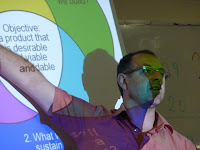Today I had brought 3 more professors with me to teach the class on multimodal interaction (I learned from Hans). As we have the pd-net project meeting Nigel Davies, Marc Langheirich, and Rui Jose were in Stuttgart and ‘volunteered’ to give a talk.
Nigel talked about the work in Lancaster on the use of mobile computing technology to support sustainable travel. He explained the experiments they conducted for collecting and sharing travel related information. In the 6th Sense Transport project they look beyond looking at understanding the current context into predictions and eventually ‘time travel’ 😉
 Marc presented a one hour version of his tutorial on privacy introducing the terminology and explaining the many facets this topic has. We discussed the ‘NTHNTF’ argument (Nothing To Hide Nothing To Fear) and Marc used an example of AOLstalker.com to show the weaknesses of this argument. Marc suggested some reading if you want to dive into the topic, see [1,2,3,4].
Marc presented a one hour version of his tutorial on privacy introducing the terminology and explaining the many facets this topic has. We discussed the ‘NTHNTF’ argument (Nothing To Hide Nothing To Fear) and Marc used an example of AOLstalker.com to show the weaknesses of this argument. Marc suggested some reading if you want to dive into the topic, see [1,2,3,4].
 Rui focused in his lecture on pervasive public displays. He gave an overview of typical architectures for digital signage systems and the resulting limitation. The pd-net approach aims at creating an open platform that allows many different applications and use cased. He showed once concept of using virtual pin-badges to trigger content and to express interest in a certain topic.
Rui focused in his lecture on pervasive public displays. He gave an overview of typical architectures for digital signage systems and the resulting limitation. The pd-net approach aims at creating an open platform that allows many different applications and use cased. He showed once concept of using virtual pin-badges to trigger content and to express interest in a certain topic.
There is more information on the pd-net project on http://pd-net.org
[1] David Brin. The Transparent Society. Perseus Publishing, 1999.
[2] Simson Garfinkel: Database Nation – The Death of Privacy in the 21st Century. O’Reilly, 2001.
[3] Lawrence Lessig: Code and Other Laws of Cyberspace. Basic Books, 2006. http://codev2.cc/
[4] Waldo, Lin, Millett (eds.): Engaging Privacy and Information Technologygy in a Digital Age. National Academies Press, 2007.







